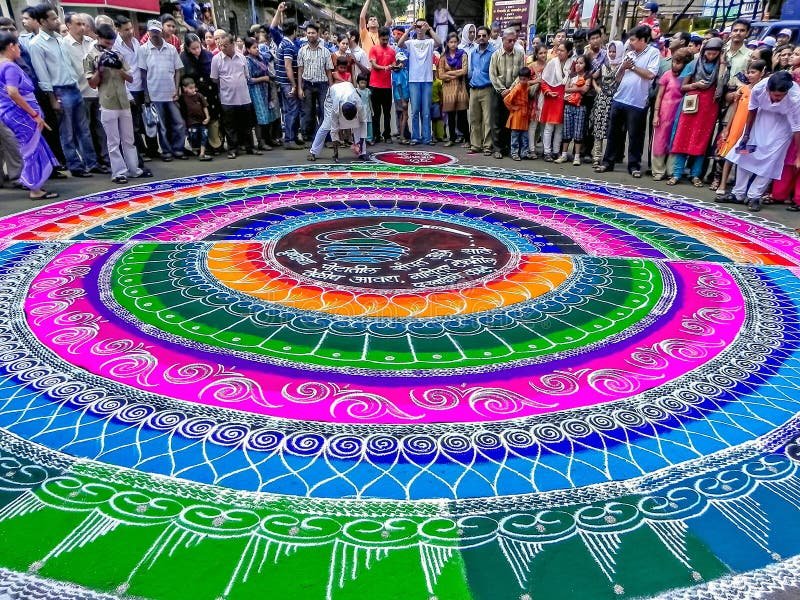In the quiet corners of Indian homes, particularly during festivals, something magical takes place. With fingers dipped in colored powders, women—often mothers and daughters—bend down at the entrance of their homes and begin to create. What follows is a burst of color, symmetry, symbolism, and culture — a visual melody composed on the floor. This is Rangoli Art, the timeless Indian art form rooted in beauty, belief, and impermanence.
But Rangoli is more than decoration; it is a sacred offering, a silent prayer, a daily ritual, and increasingly, an endangered art form in modern urban life.
In this blog, we’ll dive deep into the Rangoli Art, its historical significance, styles across regions, spiritual roots, cultural transformations, and how it has found new relevance in modern Indian and global aesthetics.
What Is Rangoli Art?
Rangoli Art is a traditional Indian art form where patterns are drawn on the floor using materials like colored powders, rice flour, flower petals, sand, and even grains. These are usually made at entrances of homes, in courtyards, or within temples — believed to invite prosperity, positive energy, and divine blessings.
The word “Rangoli” is derived from the Sanskrit words:
- ‘Rang’ (color)
- ‘Aavali’ (row or line)
Together, it signifies a row of colors.
A Brief History of Rangoli Art
Rangoli dates back thousands of years and finds mention in ancient scriptures like the Chitralakshana, believed to be the earliest treatise on Indian painting. Legends associated with its origin are just as colorful.
According to Hindu mythology, Lord Brahma once brought a dead child back to life at the behest of a grieving village. To celebrate the miracle, the villagers painted the ground with colorful powders — thus, Rangoli was born.
Over time, this visual art spread across the Indian subcontinent, evolving into regional variants such as:
- Kolam in Tamil Nadu
- Alpana in West Bengal
- Mandana in Rajasthan
- Muggulu in Andhra Pradesh
- Chowk Purana in Uttar Pradesh
Materials and Methods
Traditionally, Rangolis were made using natural materials like:
- Ground rice
- Turmeric
- Vermilion
- Flower petals (marigold, rose, jasmine)
- Charcoal dust
- Sand and chalk
Modern Rangolis often incorporate synthetic colors, acrylic paints, stencils, or even digital tools for competitions.
Some popular techniques include:
- Free-hand drawing using fingers
- Using cones or funnels for intricate patterns
- Drawing with chalk outlines first, then filling them in
- Using dots and grids for symmetrical forms
Symbolism and Spiritual Significance
Rangoli is not just art — it’s a spiritual practice.
- Welcoming Lakshmi: During Diwali, Rangolis are created to invite Goddess Lakshmi, the deity of wealth and prosperity, into homes.
- Warding off evil: The geometric precision is believed to deter evil spirits.
- Auspiciousness: Placing Rangoli at entrances signifies purity, positivity, and readiness to receive blessings.
Different motifs carry different meanings:
- Lotus: Purity and divine birth
- Conch (Shankha): Cosmic energy
- Peacock: Grace and beauty
- Swastika: Auspiciousness and good luck
Regional Styles Across India
Every region in India has its unique take on Rangoli:
- Tamil Nadu (Kolam)
Drawn with white rice powder, symbolizing prosperity and sustainability. Often created every morning at dawn. - West Bengal (Alpana)
Made using rice paste and often depicts deities, footprints, and sacred symbols during pujas. - Maharashtra (Rangoli)
Uses bright synthetic colors, often with floral, peacock, or Ganpati designs. - Rajasthan (Mandana)
Created with chalk paste and red ochre. These patterns are more tribal and geometric. - Karnataka (Rangavalli)
Uses dots as a foundation for complex patterns and symmetrical art.
The Ephemeral Philosophy of Rangoli
Perhaps the most poetic part of Rangoli is its impermanence.
Like Buddhist mandalas or Japanese sand gardens, Rangoli is created with full devotion and then allowed to fade — swept away by wind, time, or footsteps. It teaches us to appreciate the present moment, to find joy in creation, and let go without attachment.
It’s a visual metaphor for life itself — beautiful, meaningful, and fleeting.
Rangoli in the Digital Age
While urban life has made daily Rangoli less common, the tradition is being revived in creative ways:
- Rangoli competitions in schools, colleges, and social events
- Apps and software for digital Rangoli designs
- Instagram reels and YouTube tutorials showcasing artists
- AI-generated patterns and stencils
This fusion of tradition and tech is giving Rangoli a new lease of life.
Why Rangoli Still Matters Today
In an age dominated by screens and concrete, Rangoli reminds us of:
- Human connection to nature
- Mindfulness and intention
- The role of women as cultural custodians
- Celebrating community and festivity
Keeping Rangoli alive is a way of preserving heritage, nurturing creativity, and celebrating Indian identity.
How You Can Keep the Tradition Alive
- Start with a small design on festive days
- Teach children about its meaning and methods
- Use eco-friendly materials like rice flour or flower petals
- Share your designs on social media to inspire others
- Join Rangoli communities or online groups
📚 You Might Also Like:
- The Painted Temples of Hampi: Stones That Speak
- Chitrakathi of Maharashtra: Visual Storytelling for the Soul
- For More Details go to this Wikipedia
